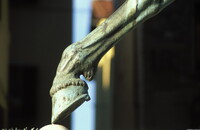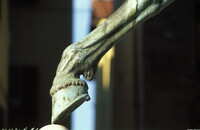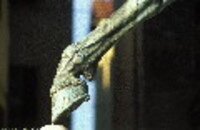| dc.coverage.spatial | Site: Florence, Tuscany, Italy | en_US |
| dc.coverage.temporal | 1587-1593 (creation) | en_US |
| dc.creator | Giambologna | en_US |
| dc.date | 1587-1593 | en_US |
| dc.date.accessioned | 2013-07-11T20:50:18Z | |
| dc.date.available | 2013-07-11T20:50:18Z | |
| dc.date.issued | 1587-1593 | en_US |
| dc.identifier | 224431 | en_US |
| dc.identifier.other | archrefid: 595 | en_US |
| dc.identifier.uri | http://hdl.handle.net/1721.3/133006 | |
| dc.description | Close view of horse, depicting lower leg and hoof; Having achieved by the 1580s a complete mastery of the human form, Giambologna turned to the subject that had fascinated the ancient Greeks and Romans almost as much, the horse. He addressed the subject with a scientific approach derived from anatomical dissections culminating in a large bronze model of a Flayed Horse (U. Edinburgh, Talbot Rice Gal., Torrie Col.). This enabled him to create his masterpiece in bronze, the equestrian statue of Cosimo I, Grand Duke of Tuscany (1587-1593; Florence, Piazza della Signoria). It was an immediate success and was replicated on the much reduced scale of statuettes, with a variety of different riders. Source: Grove Art Online; http://www.groveart.com/ (accessed 12/23/2007) | en_US |
| dc.format.medium | bronze | en_US |
| dc.rights | © Scott Gilchrist, Archivision, Inc. | en_US |
| dc.subject | animals | en_US |
| dc.subject | portraits | en_US |
| dc.subject | rulers and leaders | en_US |
| dc.subject | Medici family | en_US |
| dc.subject | Baroque | en_US |
| dc.title | Equestrian Monument to Cosimo I de' Medici, Grand Duke of Tuscany | en_US |
| dc.type | image | en_US |
| dc.rights.access | Licensed for educational and research use by the MIT community only | en_US |
| dc.identifier.vendorcode | 6A1-GB-EMC-B11 | en_US |
| vra.culturalContext | Italian | en_US |
| vra.technique | casting (process) | en_US |
| vra.worktype | sculpture (visual work) | en_US |
| dc.contributor.display | Giambologna (Flemish sculptor, 1529-1608) | en_US |


